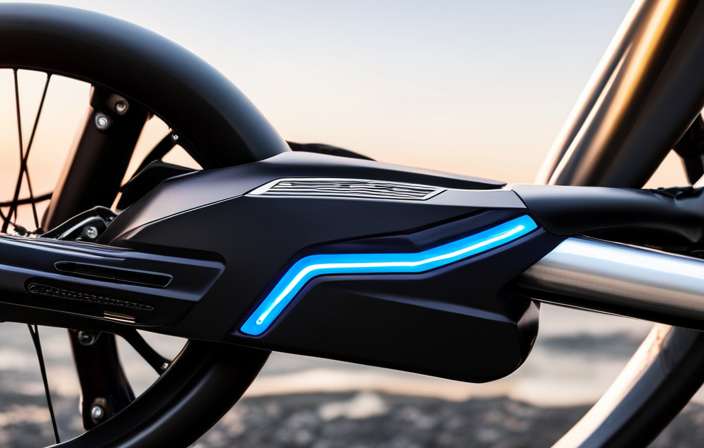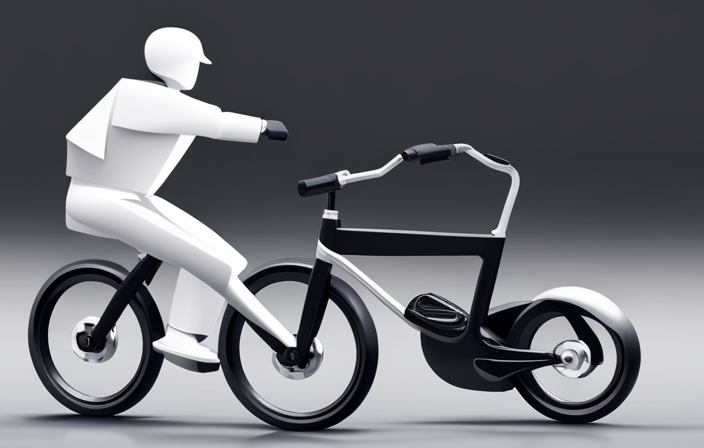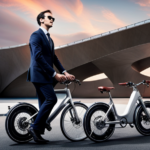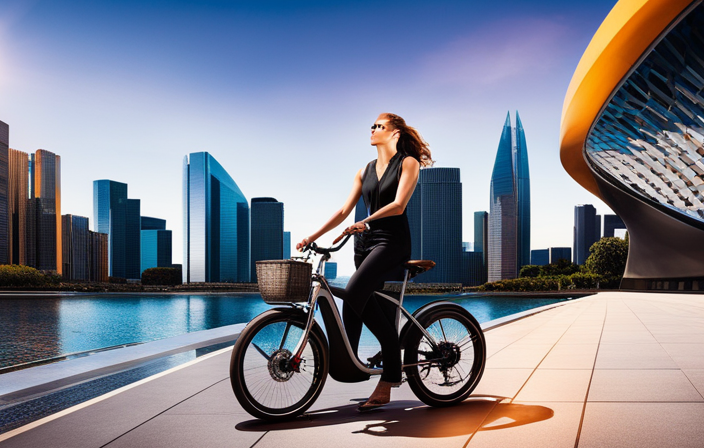Are you ready to hit the road on your electric bike but unsure about how much battery power you need? Don’t worry, we’ve got you covered!
In this informative article, we’ll delve into the world of electric bike batteries, exploring factors that affect battery life, tips to maximize it, and different types of batteries available.
With our expert guidance, you’ll gain a clear understanding of the battery options out there, so you can make an informed decision and enjoy your electric bike adventures to the fullest.
So, let’s dive in!
Key Takeaways
- Battery capacity is measured in watt-hours (Wh) and determines how much energy the battery can store.
- Higher capacity batteries provide longer ride distances.
- Proper care and maintenance, such as avoiding overcharging and extreme temperatures, are essential for battery performance and longevity.
- Upgrading to a higher capacity battery can significantly improve e-bike performance, and considering battery lifespan and warranty options is important when choosing a battery.
Understanding Electric Bike Batteries
You’ll need to understand electric bike batteries in order to determine how much battery power you’ll have.
Electric bike batteries play a crucial role in determining the range and performance of your electric bike. There are several factors that affect the battery life of an electric bike, such as the type of battery used, its capacity, and how it is charged.
Lithium-ion batteries are commonly used in electric bikes due to their high energy density and longer lifespan compared to other types of batteries. Proper battery charging techniques also play a significant role in maximizing battery life. It is important to follow the manufacturer’s guidelines for charging the battery, such as avoiding overcharging or discharging the battery completely.
Understanding these battery life factors and implementing proper charging techniques will help you determine how much battery power you’ll have for your electric bike.
Now let’s explore the various factors affecting battery life.
Factors Affecting Battery Life
To maximize your e-bike’s battery life, it’s important to consider various factors. Two key factors that affect battery life are charging time and the impact of terrain. The time it takes to fully charge your e-bike’s battery depends on its capacity and the charger’s output. Generally, a larger battery capacity will require more time to charge fully. Additionally, the terrain you ride on can significantly impact your battery life. Riding on flat terrain will typically result in longer battery life compared to riding on hilly or uneven terrain, as the motor has to work harder to overcome resistance. To optimize your battery life, it’s important to understand these factors and make choices that align with your riding needs and preferences. Transitioning into the next section, let’s explore some strategies to maximize your e-bike’s battery life.
How to Maximize Battery Life
One way to optimize your e-bike’s battery life is by implementing certain strategies. Here are some tips for maximizing battery performance and extending battery lifespan:
- Avoid frequent acceleration and deceleration as it puts strain on the battery.
- Optimize your riding style by maintaining a consistent speed and avoiding sudden bursts of power.
- Use pedal assist mode instead of relying solely on the throttle, as it reduces the load on the battery.
- Keep your e-bike’s tires properly inflated to reduce rolling resistance and improve efficiency.
- Regularly clean and lubricate the chain to ensure smooth pedaling and reduce friction.
- Store your e-bike in a cool, dry place when not in use to prevent excessive heat or moisture damage to the battery.
By following these strategies, you can maximize the performance of your e-bike’s battery and extend its lifespan.
Now, let’s move on to the next section, where we will discuss the different types of electric bike batteries.
Types of Electric Bike Batteries
When considering your e-bike, it’s important to understand the different types of batteries available. Battery performance is a crucial factor when it comes to electric bikes, and advancements in battery technology have greatly improved their capabilities.
There are several types of electric bike batteries to choose from, including lead-acid, nickel-cadmium (NiCad), nickel-metal hydride (NiMH), and lithium-ion (Li-ion) batteries.
Lead-acid batteries are the oldest and cheapest option, but they are heavy and have a limited lifespan. NiCad and NiMH batteries offer better performance and longer lifespan compared to lead-acid, but they are also heavier.
However, lithium-ion batteries are the most popular choice for electric bikes due to their high energy density, lightweight design, and longer lifespan. They offer better battery performance and have seen significant advancements in recent years.
With this understanding, let’s explore the pros and cons of lithium-ion batteries.
Lithium-ion Batteries: Pros and Cons
If you’re considering lithium-ion batteries for your e-bike, it’s important to weigh the pros and cons.
Lithium-ion batteries are widely used in various electronic devices due to their high energy density and lightweight design. In terms of battery technology, they are considered to be one of the most advanced options available for electric bikes.
These batteries offer a longer lifespan compared to other types, allowing you to enjoy more rides before needing a replacement. Additionally, lithium-ion batteries have a higher energy efficiency, meaning they can provide more power for a longer duration.
However, it’s crucial to consider the environmental impact of lithium-ion batteries. The production and disposal of these batteries can pose a risk to the environment if not managed properly.
Transitioning to the subsequent section about ‘lead-acid batteries: pros and cons,’ it’s important to explore alternative options for e-bike batteries.
Lead-acid Batteries: Pros and Cons
Lead-acid batteries, despite their lower energy density, are a popular choice for e-bikes due to their affordability and reliability. Lead acid battery technology has been used for many years and has proven to be a reliable power source for various applications. These batteries are known for their ability to provide a consistent amount of power over a long period of time, making them suitable for electric bikes.
However, one major drawback of lead-acid batteries is their environmental impact. They contain toxic materials such as lead and sulfuric acid, which can be harmful if not properly disposed of. Additionally, lead-acid batteries have a shorter lifespan compared to other battery technologies. Despite these drawbacks, many e-bike riders still opt for lead-acid batteries due to their lower cost and reliability.
Moving on to nickel-metal hydride (NiMH) batteries, they offer some advantages over lead-acid batteries.
Nickel-metal Hydride (NiMH) Batteries: Pros and Cons
NiMH batteries, on the other hand, offer a higher energy density and longer lifespan compared to their lead-acid counterparts. These batteries use a different chemistry, utilizing a combination of nickel and a metal hydride to store energy. With a higher energy density, NiMH batteries can store more energy in a smaller size, making them a popular choice for electric bikes. Additionally, they have a longer lifespan, which means they can be recharged and used for a longer period of time before needing to be replaced. However, it’s important to consider the environmental impact of NiMH batteries. While they don’t contain toxic lead like lead-acid batteries, they do contain other heavy metals that can be harmful if not disposed of properly. When comparing battery capacities, it’s essential to take into account the advantages and disadvantages of each battery chemistry.
Comparing Battery Capacities
When comparing battery capacities, you’ll need to consider the energy density and lifespan of each type.
The battery lifespan refers to the number of charge cycles a battery can go through before its capacity significantly decreases. Different battery chemistries have varying lifespans. For example, lithium-ion batteries have a longer lifespan compared to nickel-metal hydride (NiMH) batteries.
Evaluating the cost effectiveness of different battery capacities is also crucial. While batteries with higher capacities may provide longer riding distances, they tend to be more expensive. It’s important to find a balance between battery capacity and cost to ensure you’re getting the most value for your money.
Now that you understand battery capacities, let’s move on to charging your electric bike battery efficiently.
Charging Your Electric Bike Battery
Now that you have a good understanding of how different battery capacities can affect the performance of your electric bike, let’s talk about charging options and common battery issues.
When it comes to charging your electric bike battery, you have a few options. The most common method is to simply plug your bike into a standard electrical outlet using the charger that came with your bike. Some electric bikes also have the option to remove the battery and charge it separately. It’s important to follow the manufacturer’s instructions for charging your specific battery model to ensure proper charging and avoid any potential issues.
Speaking of which, common battery issues include overcharging, undercharging, and charging at extreme temperatures. These can all affect the overall lifespan and performance of your battery.
Now that you’re aware of charging options and common battery issues, let’s move on to the next section about battery maintenance and care tips.
Battery Maintenance and Care Tips
Taking proper care of your e-bike’s battery is essential for maintaining its performance and longevity. Here are some important tips to ensure your battery stays in optimal condition:
-
Battery storage: When storing your electric bike for an extended period, make sure to remove the battery and store it in a cool, dry place. Avoid exposing it to extreme temperatures or direct sunlight, as this can damage the cells.
-
Regular charging: Charge your battery regularly, even if you haven’t used your e-bike. This helps prevent deep discharge and keeps the cells active.
-
Avoid overcharging: Overcharging can reduce the battery’s lifespan. Always unplug the charger once the battery is fully charged.
-
Troubleshooting common battery issues: If you encounter any problems with your battery, such as sudden drops in capacity or difficulty charging, consult your manufacturer’s manual or contact customer support for assistance.
-
Proper handling: Handle your battery with care, avoiding impacts or drops that could damage the cells.
By following these maintenance tips, you can ensure your battery performs optimally, minimizing the risk of common issues.
Now, let’s address the common concern of ‘range anxiety: debunking the myths.’
Range Anxiety: Debunking the Myths
Range anxiety, a common concern among e-bike riders, can be easily debunked with some factual information. Many people have misconceptions about the range of electric bikes, leading to unnecessary worry. Let’s take a look at some common myths and the truth behind them.
| Myth | Truth |
|---|---|
| Electric bikes have a short range. | Modern e-bikes can travel up to 100 miles on a single charge, depending on factors like terrain and rider weight. |
| Running out of battery is a big issue. | Most electric bikes can still be pedaled like regular bikes when the battery runs out, giving you a backup option. |
| Recharging takes a long time. | With fast-charging technology, e-bike batteries can be fully charged in just a few hours, making it convenient for daily use. |
| Range decreases over time. | While slight degradation is inevitable, proper battery care can help maintain the range of your e-bike for years to come. |
By understanding these facts, you can overcome range anxiety and enjoy the full potential of your electric bike. Now, let’s explore the next section on upgrading your electric bike battery.
Upgrading Your Electric Bike Battery
To enhance your e-bike experience, consider upgrading the battery. Upgrading techniques can significantly improve your electric bike’s performance and range.
One option is to choose a higher capacity battery. A larger capacity battery will provide more power, allowing you to travel longer distances without needing to recharge.
Another technique is to opt for a battery with a higher voltage. Higher voltage batteries can deliver more power to the motor, resulting in faster acceleration and better climbing ability.
Additionally, you can upgrade to a battery with a better chemistry, such as lithium-ion, which offers higher energy density and longer lifespan compared to older battery technologies.
By following these battery performance tips, you can enjoy a more efficient and reliable electric bike.
Now, let’s explore battery warranty and replacement options.
Battery Warranty and Replacement Options
One option for enhancing your e-bike experience is to upgrade the battery’s warranty and explore replacement options. By doing so, you can ensure that your investment is protected and that you have peace of mind in case anything goes wrong with your battery. It’s important to consider the battery lifespan and performance when choosing a warranty and replacement option. Some manufacturers offer extended warranties that cover the battery for a longer period of time, while others provide replacement options that allow you to easily swap out your old battery for a new one if needed. To help you make an informed decision, take a look at the table below that compares different warranty and replacement options available in the market:
| Manufacturer | Warranty Length | Replacement Option |
|---|---|---|
| Brand A | 2 years | Yes |
| Brand B | 3 years | No |
| Brand C | 5 years | Yes |
| Brand D | 1 year | Yes |
| Brand E | 4 years | No |
Considering the importance of battery lifespan and performance, it’s crucial to choose a warranty and replacement option that aligns with your needs and preferences. Looking ahead, let’s explore future innovations in electric bike batteries.
Future Innovations in Electric Bike Batteries
Innovations in e-bike batteries are expected to revolutionize the cycling industry. The future advancements in battery technology will bring about significant changes, making electric bikes more efficient and powerful than ever before.
One of the key areas of focus is sustainable power sources. Manufacturers are exploring the use of renewable energy, such as solar or wind power, to charge the batteries. This would not only reduce the environmental impact but also provide a more reliable and sustainable source of energy for the bikes.
Additionally, advancements in battery chemistry and design will lead to increased energy density, allowing for longer rides without the need for frequent recharging. These advancements will undoubtedly enhance the overall performance and usability of electric bikes.
Looking ahead, it is important to consider these future innovations when choosing the right battery for your electric bike, as they will greatly impact your riding experience. Ultimately, finding the right battery will ensure a smooth and enjoyable journey on your electric bike.
Final Thoughts: Choosing the Right Battery for Your Electric Bike
When it comes to selecting the perfect battery for your e-bike, make sure you consider all the factors that will enhance your riding experience.
One important factor to consider is choosing the right battery capacity. Battery capacity is measured in watt-hours (Wh) and determines how much energy the battery can store. The higher the capacity, the longer your e-bike can go without needing a recharge.
Another factor to consider is battery performance indicators. These indicators include things like voltage, current, and temperature, which can affect the overall performance and lifespan of the battery. It’s important to choose a battery that has good performance indicators to ensure optimal performance and longevity.
By carefully considering battery capacity and performance indicators, you can choose the right battery for your e-bike that will provide a smooth and enjoyable riding experience.
Frequently Asked Questions
How do I dispose of my old electric bike battery?
To dispose of your old electric bike battery, there are several disposal methods and recycling options available.
One option is to contact your local recycling center or hazardous waste facility to inquire about their battery recycling programs. Many cities have drop-off locations where you can safely dispose of your old battery.
Additionally, some bike shops or manufacturers may offer battery recycling services. It’s important to properly dispose of your old battery to minimize environmental impact.
Can I use a different type of battery for my electric bike?
Did you know that there are various types of batteries available for electric bikes? It’s important to note that not all batteries are compatible with every electric bike.
Different battery types, such as lithium-ion and lead-acid, have specific voltage and capacity requirements that need to match the bike’s system. Using an incompatible battery can lead to performance issues or even damage your electric bike.
Always consult the manufacturer or a professional to ensure the right battery type for your electric bike.
How long does it take to fully charge an electric bike battery?
To fully charge an electric bike battery, it typically takes around 3 to 6 hours. The charging time may vary depending on the battery’s capacity and the charger’s power output.
It’s important to follow the manufacturer’s guidelines for charging to ensure optimal performance and battery lifespan. Regularly charging the battery within the recommended time frame can help extend its overall lifespan and ensure you have a reliable power source for your electric bike.
Can I charge my electric bike battery with a solar panel?
Yes, you can charge your electric bike battery with a solar panel. The efficiency of the solar panel plays a crucial role in the charging process. For example, if your solar panel has an efficiency of 20%, it can convert 20% of the sunlight it receives into electricity.
However, the battery capacity also matters. A larger battery capacity will require more time to charge, even with a high-efficiency solar panel.
Are there any safety precautions I should take when handling my electric bike battery?
When handling your electric bike battery, it is crucial to observe safety precautions to prevent accidents and ensure optimal battery performance.
Always wear protective gloves and eyewear to avoid contact with any corrosive substances.
Keep the battery away from extreme temperatures and avoid exposing it to water or other liquids.
Regularly inspect the battery for any signs of damage or leakage.
Additionally, follow manufacturer guidelines for proper battery maintenance to prolong its lifespan.
Conclusion
In conclusion, when it comes to choosing the right battery for your electric bike, it’s crucial to understand the factors affecting battery life and how to maximize its efficiency.
Remember that lithium-ion batteries are the most popular choice due to their high energy density and long lifespan.
Interestingly, did you know that a fully charged lithium-ion battery can take you on a journey of up to 100 miles? This impressive statistic highlights the incredible capabilities of electric bike batteries and the potential for a truly exhilarating ride.
















